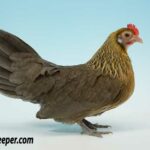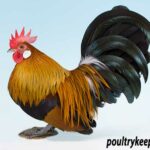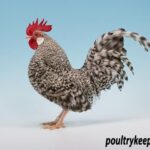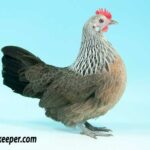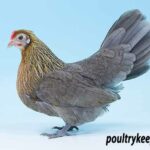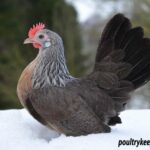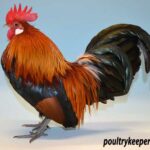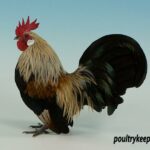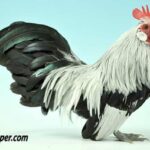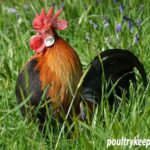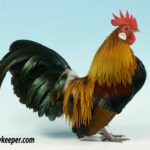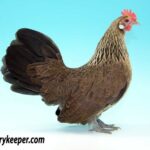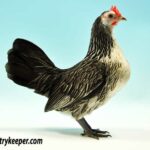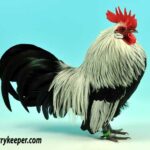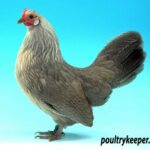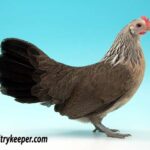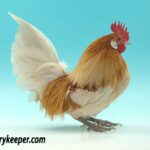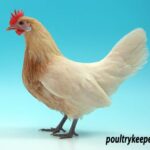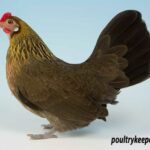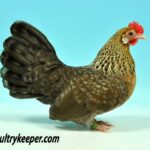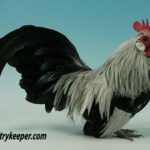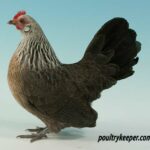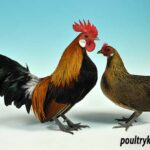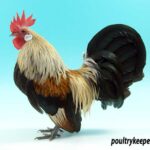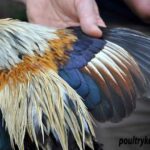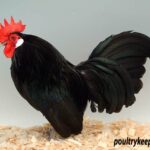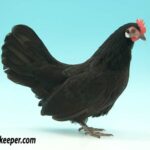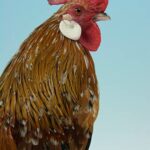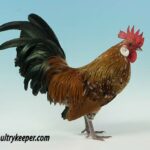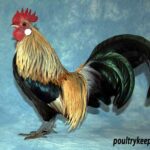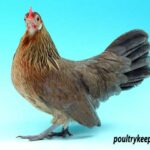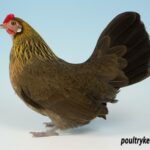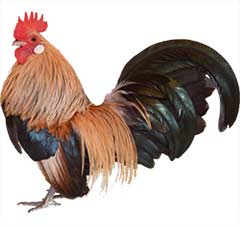
Uses: Exhibition / Ornamental.
Eggs: 80 – 160 tinted.
Origin: Holland.
Weight: Bantam Cock: 500 – 550g, Hen: 400 – 450g.
Colours: Gold Partridge, Silver Partridge, Yellow Partridge, Blue Silver Partridge, Blue Yellow Partridge, Blue Partridge, Red Shouldered White (Pile), Cuckoo Partridge (Crele), Cuckoo, Black, White, Blue, Lavender.
Useful to Know: A true bantam. Hardy. Can make a good broody but only covers a small number of eggs. Good temperament and can become quite friendly.
Photo: Yellow Dutch Bantam owned by Jane Eardley.
Dutch Bantams were developed in Holland during the 1880s after birds were imported from the Dutch East Indies on ships that carried them to supply meat and eggs whilst at sea. Stories say that the local peasants were required to give any large hens eggs that they had to their landowner, so they took a liking to these birds since they laid such small eggs that they could keep for themselves.
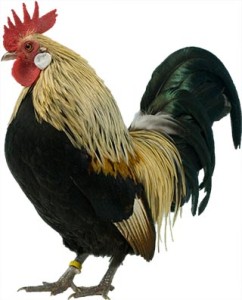 Dutch Bantams are true bantams (they do not have a large fowl counterpart) and are one of the smallest bantams. The first imports into the UK were not until the early 1970’s and soon became very popular in the UK. It was Easter 1982, that the Dutch Bantam Club was formed, taking over from the Rare Poultry Society, at a meeting at Malpas and Whitchurch Poultry Show.
Dutch Bantams are true bantams (they do not have a large fowl counterpart) and are one of the smallest bantams. The first imports into the UK were not until the early 1970’s and soon became very popular in the UK. It was Easter 1982, that the Dutch Bantam Club was formed, taking over from the Rare Poultry Society, at a meeting at Malpas and Whitchurch Poultry Show.
At the time, this was the largest one day show in the country. The secretary of the Rare Poultry Society at the time was Richard Billson.
In the U.S. they arrived much earlier (around 1945) but appear to have died out in the 1950’s. They were re-imported during the 1970’s and soon became popular. The American Dutch Bantam Society was formed in 1986. Dutch Bantams are popular in Switzerland. They arrived there in 1968 and a breed club was formed in 1982.
The British Standards for the different colours of Dutch Bantams were accepted by the Poultry Club of Great Britain over a number of years but it is thought (can anyone confirm this for us??) that the Gold and Silver were Standardised before the Club was formed in 1982. They first entered the American Poultry Standards in 1992.
Dutch Bantams are called Hollandse Kriel in Holland, Naine Hollandaise in France and Holländische Zwerghühner in Germany.
Photos
Books
The following books are available. Links take you to the Amazon or other sellers’ pages for the books.
- Popular Poultry Breeds – D. Scrivener – P.67
- British Poultry Standards – P.104
- Storey’s Illustrated Guide to Poultry Breeds – C. Ekarius P.119
- American Standard of Perfection – P.368
Breed Clubs
These are the breed clubs for Dutch Bantams:
- UK: The Dutch Bantam Club
- US: The Dutch Bantam Society
- NL: Hollandse Krielenfokkers Club
- DE: The German-Dutch Bantam Club.
Other True Bantam Breeds
Belgian Bantams
No. of Eggs 3.5/5 Easy to Keep? 2.5/5 Uses: Exhibition. Eggs: 200 – 250 tinted / brown.Origin: Belgium.Weight: Cock: 680-790g max, Hen: 570-680g
Booted Bantams
No. of Eggs 2.5/5 Easy to Keep? 2/5 Uses: Exhibition. Eggs: 150 – 180 tinted.Origin: Germany, The Netherlands, Great Britain.Weight: Cock: 850g, Hen:
Japanese Bantams
No. of Eggs 2.2/5 Easy to Keep? 3.5/5 Uses: Exhibition / Ornamental.Origin: Japan. Eggs: 80 – 160 white, cream or brown.Weight: Cock: 510 – 600g, Hen: 400 – 510g.Colours: Black Tailed
Pekin Bantams
No. of Eggs 2.2/5 Easy to Keep? 3.5/5 Uses: Exhibition.Origin: Peking, China. Eggs: 120 – 160 White / Cream.Weight: Cock: 680g Max.Hen: 570g Max.Colours: Black, Blue, Buff, Cuckoo, Mottled, Barred,
Rosecomb Bantams
No. of Eggs 2.5/5 Easy to Keep? 3.5/5 Uses: Exhibition. Eggs: 150 – 180 white or cream. Origin: Great Britain. Weight: Cock: 570g
Serama Bantams
No. of Eggs 2.2/5 Easy to Keep? 3.5/5 Uses: Exhibition / Ornamental / Pet. Origin: Malaysia. Eggs: 80 – 160 brown to white.
Sebright Bantams
No. of Eggs 1.1/5 Easy to Keep? 3.5/5 Uses: Exhibition / Ornamental.Origin: England. Eggs: 50 – 80 white.Weight: Cock: 620 g. Hen: 510 g.Colours: Gold, Silver. (Standardised UK).Useful to Know: A true

